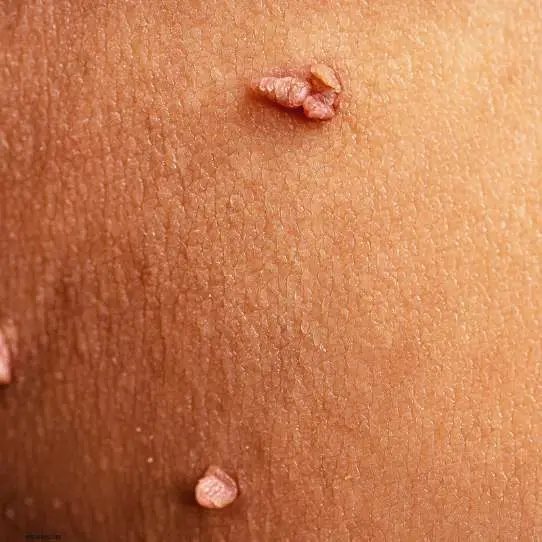Say Goodbye to Skin Tags with These Effective Home Remedies
Say goodbye to unsightly skin tags with these effective home remedies that will leave your skin looking smooth and flawless. Skin tags are small, benign growths that commonly appear on the neck, underarms, and groin area. While they are harmless, many people find them annoying and unattractive. Instead of resorting to expensive medical treatments or painful procedures, why not try some simple and natural remedies that you can easily find in your kitchen?
In this article, we will explore a range of home remedies to help you get rid of skin tags safely and effectively. From apple cider vinegar and tea tree oil to baking soda and essential oils, we will provide you with step-by-step instructions on how to use these ingredients to eliminate skin tags.
Not only are these remedies cost-effective, but they also avoid the potential risks and side effects associated with medical interventions. So, if you’re looking for a natural and affordable way to say goodbye to skin tags, keep reading to discover the secrets to healthy and blemish-free skin.

Causes of Skin Tags
Skin tags, also known as acrochordons, are small, benign growths that commonly appear on the skin. These harmless skin formations are typically flesh-colored or slightly darker and can range in size from a few millimeters to several centimeters. While they are not a cause for medical concern, many people find them unsightly and wish to remove them.
There are several factors that can contribute to the development of skin tags. One of the primary causes is friction and skin-to-skin contact. Areas of the body where skin rubs against skin, such as the neck, armpits, groin, and eyelids, are more prone to the formation of skin tags. Individuals who are overweight or obese are also more susceptible to developing skin tags due to the increased skin-to-skin contact in these areas.
Hormonal changes can also play a role in the appearance of skin tags. Pregnancy, for example, can trigger the growth of skin tags due to the fluctuations in hormone levels. Additionally, certain medical conditions like diabetes and polycystic ovarian syndrome (PCOS) have been linked to an increased risk of skin tag development. Genetics may also be a factor, as some people are more predisposed to forming skin tags than others.
Why opt for home remedies?
When it comes to dealing with skin tags, many people are hesitant to undergo medical procedures or treatments due to the potential risks, side effects, and high costs associated with them. This is where home remedies can be an attractive alternative.
One of the primary advantages of using home remedies for skin tags is their cost-effectiveness. Medical treatments, such as cryotherapy, laser removal, or surgical excision, can be quite expensive, especially if multiple sessions are required. In contrast, many of the natural ingredients used in home remedies, such as apple cider vinegar, tea tree oil, and baking soda, are readily available and inexpensive.
Another benefit of home remedies is their gentleness on the skin. Medical procedures can sometimes be invasive and may cause irritation, inflammation, or scarring. Home remedies, on the other hand, are generally less harsh and can be tailored to individual skin types and sensitivities. This can be particularly important for individuals with sensitive skin or those who wish to avoid the potential side effects of more aggressive treatments.
Furthermore, home remedies offer a level of control and convenience that may not be available with medical interventions. Individuals can choose the specific ingredients and methods that work best for their skin and can apply the treatments at their own pace and in the comfort of their own homes. This can be especially appealing for those who prefer a more natural and holistic approach to skin care.


Tea tree oil for skin tags
Tea tree oil, also known as melaleuca oil, is a popular natural remedy for a variety of skin conditions, including the removal of skin tags. This essential oil is derived from the leaves of the Melaleuca alternifolia tree, native to Australia, and is known for its potent antimicrobial, anti-inflammatory, and skin-healing properties.
The active compounds in tea tree oil, such as terpinen-4-ol and alpha-terpineol, are believed to have the ability to dry out and eventually cause the skin tag to fall off. When applied topically, tea tree oil can help to reduce the size and appearance of the skin tag over time.
To use tea tree oil for skin tags, start by cleaning the affected area with a mild soap and water. Gently pat the skin dry, then apply a small amount of pure, undiluted tea tree oil directly onto the skin tag using a cotton swab. Be sure to avoid getting the oil on the surrounding healthy skin, as it can cause irritation.
After applying the tea tree oil, cover the area with a small bandage or adhesive strip to keep the oil in place. Repeat this process once or twice daily, depending on the size and severity of the skin tag. It’s important to be patient, as it may take several weeks or even months for the skin tag to completely disappear.
In addition to its direct application, tea tree oil can also be combined with other natural ingredients, such as apple cider vinegar or castor oil, to create a more potent skin tag remedy. Always perform a patch test first to ensure that you do not have any adverse reactions to the oil or the combination of ingredients.
Garlic for skin tags
Garlic is another natural remedy that has been used for centuries to address a variety of skin conditions, including the removal of skin tags. This pungent herb is rich in sulfur compounds, such as allicin, which are believed to have powerful antimicrobial and anti-inflammatory properties that can help to eliminate skin tags.
To use garlic for skin tags, start by crushing a fresh clove of garlic to release its active compounds. Apply the crushed garlic directly onto the skin tag, making sure to cover the entire growth. Secure the garlic in place with a small bandage or adhesive strip.
Leave the garlic on the skin tag for at least 30 minutes, or up to a few hours, before rinsing it off with warm water. Repeat this process once or twice a day, depending on the size and severity of the skin tag. Be patient, as it may take several applications over the course of a few weeks for the skin tag to dry up and fall off.
In addition to using fresh garlic, you can also try creating a garlic-based ointment or paste by mixing crushed garlic with a carrier oil, such as coconut or olive oil. This can help to keep the garlic in place and prevent it from drying out too quickly.
It’s important to note that garlic can be quite potent and may cause skin irritation in some individuals. Always perform a patch test before applying garlic directly to the skin tag, and discontinue use if you experience any redness, swelling, or discomfort.


Apple cider vinegar for skin tags
Apple cider vinegar is another popular home remedy for the removal of skin tags. This versatile kitchen staple is believed to work by drying out and causing the skin tag to eventually fall off due to its acidic properties.
To use apple cider vinegar for skin tags, start by diluting the vinegar with a small amount of water to create a 50/50 solution. Gently apply the diluted apple cider vinegar directly onto the skin tag using a cotton ball or swab. Be sure to avoid getting the vinegar on the surrounding healthy skin, as it can cause irritation.
Once the apple cider vinegar solution is in place, cover the area with a small bandage or adhesive strip to keep the vinegar from drying out too quickly. Leave the bandage on for at least 30 minutes, or up to a few hours, before removing it and rinsing the area with warm water.
Repeat this process once or twice a day, depending on the size and severity of the skin tag. You may notice the skin tag starting to dry out and turn black over the course of a few days or weeks. Be patient and persistent, as it may take several applications for the skin tag to fully disappear.
In addition to using apple cider vinegar alone, you can also try combining it with other natural ingredients, such as baking soda or tea tree oil, to create a more potent skin tag remedy. Always perform a patch test first to ensure that you do not have any adverse reactions to the vinegar or the combination of ingredients.
Dr. Cole’s Extraction Balm for skin tags
While home remedies can be an effective and affordable option for removing skin tags, some individuals may prefer a more targeted and professional-grade solution. One such option is Dr. Cole’s Extraction Balm, a specialized topical treatment designed to safely and effectively remove skin tags without the need for invasive medical procedures.
Developed by renowned naturopath, Dr. Janell Cole, this balm contains a unique blend of natural ingredients, including tea tree oil, bloodroot, and vitamin E, that work together to dry out and eliminate skin tags. The formula is gentle enough for sensitive skin, yet powerful enough to tackle even stubborn or persistent skin growths.
To use Dr. Cole’s Extraction Balm, simply apply a small amount directly onto the skin tag using a cotton swab or your finger. Gently massage the balm into the skin tag, making sure to cover the entire growth. Once applied, cover the area with a small bandage or adhesive strip to keep the balm in place.
Leave the balm on the skin tag for at least 30 minutes, or up to a few hours, before rinsing it off with warm water. Repeat this process once or twice a day, depending on the size and severity of the skin tag. You may notice the skin tag starting to dry out and shrink over the course of a few days or weeks.
One of the key benefits of Dr. Cole’s Extraction Balm is its precision and targeted approach. Unlike some home remedies that can potentially irritate the surrounding skin, this balm is formulated to focus solely on the skin tag, helping to minimize the risk of any unwanted side effects. Additionally, the inclusion of vitamin E and other nourishing ingredients can help to soothe and heal the skin after the skin tag has been removed.

Conclusion: When to consult a dermatologist
While home remedies can be an effective and cost-effective way to remove skin tags, there are some instances where it may be best to consult a dermatologist. If you have a large or persistent skin tag, or if the skin tag is located in a sensitive area, such as the eyelid, it’s important to seek professional medical advice.
Dermatologists can provide a thorough evaluation and recommend the most appropriate treatment option, whether that’s a medical procedure like cryotherapy or laser removal, or a more targeted home remedy approach. They can also help to rule out any underlying medical conditions that may be contributing to the development of skin tags.
Additionally, if you notice any changes in the appearance or behavior of a skin tag, such as rapid growth, bleeding, or changes in color, it’s important to have it examined by a dermatologist. These could be signs of a more serious skin condition that requires professional medical attention.
Remember, while home remedies can be a safe and effective way to remove skin tags, it’s always best to approach any skin condition with caution and consult a qualified healthcare professional if you have any concerns, doubts, or have not tried home remedies in the past. With the right treatment approach, you can say goodbye to unsightly skin tags and enjoy healthy, blemish-free skin.

